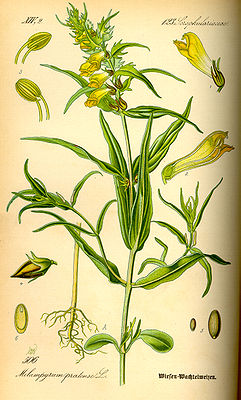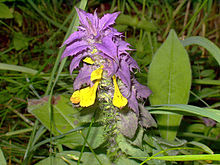Quail wheat
| Quail wheat | ||||||||||||
|---|---|---|---|---|---|---|---|---|---|---|---|---|

Meadow quail wheat ( Melampyrum pratense ), illustration |
||||||||||||
| Systematics | ||||||||||||
|
||||||||||||
| Scientific name | ||||||||||||
| Melampyrum | ||||||||||||
| L. |
The genus quail wheat ( Melampyrum ) belongs to the family of summer root plants (Orobanchaceae).
The interpretation of the German name relates to the quail's supposed preference for the seeds of quail wheat.
Description and

Vegetative characteristics
Melampyrum species grow as annual herbaceous plants .
The opposite leaves are usually sessile. There are no stipules. The simple leaf blades are entire.
Generative characteristics
The flowers stand individually in the axils of bracts or in racemose- like inflorescences . The bracts are foliage-shaped and their edge often has pointed or bristly teeth, rarely it is smooth.
The hermaphrodite flowers are zygomorphic with a double flower envelope . The four sepals are fused bell-shaped. Of the four calyx teeth, the upper pair is longer than the lower. The five petals are fused Roehrig. The corolla tube gradually widens upwards. The crown throat is widened. The crown is two-lipped. The lower lip is open, its base is two-fold and its upper end is trilobed. The helmet-shaped upper lip is compressed, slightly shorter than the lower lip, with a bent-back edge and a blunt upper end. The four fertile stamens are enveloped by the helmet-shaped upper lip; one pair of stamens is shorter than the other. Two carpels are an above-permanent, two-chambered ovary grown. Each ovary chamber contains two ovules . The stylus ends in a simple, head-shaped scar.
The egg-shaped, somewhat flattened, straight or crooked capsule fruits have a blunt or pointed upper end, open in fissures (loculicide) and contain one to four seeds. The relatively large seeds are elongated and smooth.
ecology
All Melampyrum species are semi-parasites (hemiparasites).
Toxicity
The plant parts of the genus Melampyrum are poisonous due to the glycoside aucubin .
Systematics and distribution



The genus Melampyrum was established in 1753 by Carl von Linné in Species Plantarum , 2, page 605. Type species is Melampyrum pratense L. The botanical genus name Melampyrum is derived from field quail wheat ( Melampyrum arvense ); In the past, contamination with quail wheat seeds could lead to flour poisoning and blackening of the bread (Greek words melas for "black", pyros for "wheat").
The genus Melampyrum belongs to the tribe Rhinantheae within the family of Orobanchaceae .
The genus Melampyrum is common in the northern hemisphere . There are three types in China.
There are around 20 types of Melampyrum (selection):
- Melampyrum alboffianum Beauverd
- Melampyrum ambiguum Soó
- Field quail wheat ( Melampyrum arvense L. )
- Bearded Quail Wheat ( Melampyrum barbatum Willd. )
- Melampyrum bihariense A. Kern .
- Melampyrum bohemicum A. Kern.
- Melampyrum catalaunicum Freyn : It occurs in Spain and Italy.
- Melampyrum caucasicum Bunge
- Melampyrum chlorostachyum Beauverd
- Melampyrum ciliatum Boiss. & Hero.
- Comb quail wheat ( Melampyrum cristatum L. )
- Melampyrum degenianum Soó
- Melampyrum doerfleri Ronniger
- Melampyrum elatius (Boiss.) Soó
- Melampyrum fimbriatum Vandas : It occurs in Italy, Slovenia, Croatia, Albania and Greece.
- Melampyrum heracleoticum Boiss. & Orph.
- Melampyrum herbichii Wolł.
- Melampyrum hoermannianum K.Malý
- Melampyrum italicum Soó : It occurs in Italy.
- Melampyrum linear desr. : It occurs in Canada and the United States.
- Melampyrum mulkijanianii T.N. Popova
- Grove quail wheat ( Melampyrum nemorosum L. )
- Polish quail wheat ( Melampyrum polonicum (Beauverd) Soó )
- Meadow quail wheat ( Melampyrum pratense L. )
- Melampyrum saxosum Baumg.
- Melampyrum scardicum Wettst.
- Melampyrum stenophyllum Boiss.
- Narrow-leaf quail wheat ( Melampyrum subalpinum (Jur.) A.Kern. )
- Forest quail wheat ( Melampyrum sylvaticum L. )
- Melampyrum trichocalycinum Vandas
- Melampyrum variegatum Huter, Porta & Rigo : It occurs in Italy.
- Melampyrum vaudense (Ronniger) Soó : It occurs in France and Switzerland.
- Melampyrum velebiticum Borbás : It occurs in France, Italy, Switzerland, Slovenia and Croatia.
Individual evidence
- ↑ a b c d e f g h i Zhi-Yun Zhang, Nikolai N. Tzvelev: Melampyrum Linnaeus , p. 90 - online with the same text as the printed work , In: ZY Wu, PH Raven (ed.): Flora of China , volume 18: Scrophulariaceae through Gesneriaceae. Science Press, Beijing and Missouri Botanical Garden Press, St. Louis, 1998, ISBN 0-915279-55-X .
- ↑ Melampyrum at Tropicos.org. Missouri Botanical Garden, St. Louis, accessed January 31, 2018.
- ↑ a b Melampyrum in the Germplasm Resources Information Network (GRIN), USDA , ARS , National Genetic Resources Program. National Germplasm Resources Laboratory, Beltsville, Maryland. Accessed January 31, 2018.
- ↑ a b c d e f g h i j k l m n o p q r s t u v w x y z aa ab ac ad ae af ag Karol Marhold (2011+): Melampyrum L .: Datasheet In: Euro + Med = Plantbase - the information resource for Euro-Mediterranean plant diversity .
literature
- Hans Christian Weber: Parasitism of flowering plants. Scientific Book Society, Darmstadt 1993, ISBN 3-534-10529-X .
- Hans Christian Weber: Schmarotzer: Plants that live on others . Belser, Stuttgart 1978, ISBN 3-7630-1834-4
- Károly Rezsö Soó from Bere, David Allardice Webb: Melampyrum L. In: Thomas Gaskell Tutin et al. (Ed.): Flora Europaea . tape 3 . Cambridge University Press, 1972, ISBN 0-521-08489-X , pp. 253-257 ( Melampyrum L. on pages 253-257 in the Google book search).
- Gerhard Wagenitz (Hrsg.): Illustrated flora of Central Europe. Founded by Gustav Hegi . 2nd Edition. Volume VI, Part 1A: Spermatophyta: Angiospermae: Dicotyledones 4 (1). Delivery 1. Jürgen Pusch, Karl-Friedrich Günther: Orobanchaceae (summer root plants). Weißdorn, Jena 2009, ISBN 978-3-936055-33-7 . Pp. 1-99.